|
BATTLE OF ATLANTA
The night was hot, the roads dusty, and Hardee's soldiers already
were half-exhausted from two days of fighting and marching, having spent
July 21 holding the Federals east of Atlanta in check. Soon it became
apparent that they could not hope to reach Decatur by morning. Hood
thereupon, at Hardee's request, modified his plan: Wheeler would proceed
to Decatur, where McPherson's wagon train reportedly was parked, but
Hardee would attack as soon as he got beyond McPherson's flank.
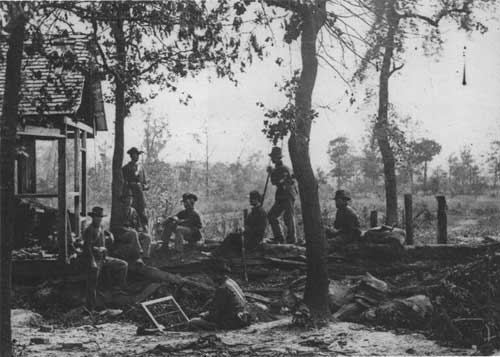
|
UNION SOLDIERS ARE PHOTOGRAPHED ON THE LINES BEFORE ATLANTA SHORTLY
BEFORE THE BATTLE ON JULY 22. (LC)
|
Sherman, when informed early on the morning of July 22 that the enemy
seemed to have withdrawn from in front of McPherson and Schofield, at
once concluded that Hood was evacuating Atlanta and so instructed
Schofield to occupy the city while the rest of the army gave pursuit.
Then, on discovering that strong Confederate forces still occupied a
line closer to Atlanta, Sherman decided that Hood intended to hold the
place after all and that therefore the time had come to execute the
strategy for taking it that he had outlined to Grant back in April: cut
its railroad connections to the Confederacy. One of these, the line
between Atlanta and Montgomery, already had been severed by a recent
raid out of Tennessee into Alabama by Major General Lovell Rousseau's
cavalry. Hence Sherman ordered McPherson to send Dodge's XVI Corps back
to the Decatur area to wreak further destruction on the Georgia Railroad
to Augusta, after which the Army of the Tennessee would swing north,
then west of Atlanta to strike the Macon & Western Railroad, the
breaking of which would completely isolate the city.
McPherson did not like this order and he went to Sherman to tell him
why: large Confederate forces had been seen moving south and he feared
an attack on his vulnerable left flank. Sherman, although he thought
McPherson's concern was unwarranted, agreed to postpone the
implementation of the order until 1 P.M. If by then the Rebels had not
attacked, they never would.
The morning passed and no attack came. At noon Sherman sent a message
to McPherson instructing him to direct Dodge to send Brigadier General
John Fuller's division of the XVI Corps to Decatur to tear up tracks but
to leave that corps other division, Sweeny's, where it was, namely to
the rear of McPherson's flank to which point it had marched during the
morning after having been posted the previous evening on the right flank
of the Army of the Tennessee to plug a gap between it and the XXIII
Corps. McPherson did as Sherman directed. But before his dispatch could
reach Dodge, an increasingly loud sound of firing came from the
southeast.
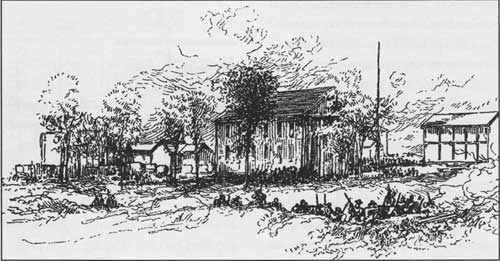
|
SPRAGUE'S BRIGADE AT DECATUR, GEORGIA. (BL)
|
It was Hardee, at long last launching his attack on the Union left
and rear. Through no fault of his, its timing could not have been more
unfavorable. Had it occurred either an hour sooner or an hour later, his
two right divisions, Bate's and Walker's, would have met no opposition
or only Sweeny's division. Instead, they encountered both Fuller and
Sweeny. And to make matters worse, Bate's troops had to struggle across
a swamp and Walker was killed by a Federal sniper before he could even
deploy his division. As a result, the Confederate attack in this sector
lacked cohesion and punch and soon was repulsed.
Likewise, Wheeler, although he took Decatur, failed to capture
McPherson's wagon train, which escaped along with most of the Federals
defending the place.
Cleburne's troops, on going into action, enjoyed better luck, for
they happened to enter a wide gap between the right of XVI Corps and the
left of the XVII Corps, which was at the south end of McPherson's line
facing Atlanta. Furthermore, as they advanced McPherson himself,
accompanied only by an orderly, came riding among them on his way to
check the XVII Corps' situation after witnessing he XVI Corps beat back
Bate's and Walker's attack. The Confederates yelled at him to surrender;
instead he tried to escape and was shot dead from his horse. As he
demonstrated on May 9 at Resaca, and two days earlier on the road to
Atlanta, he was too lacking in aggressiveness to be a first-rate combat
commander, but his caution served the Union cause well on July 22.
Pushing on, Cleburne's men struck the flank and rear of the XVII
Corps while Cheatham's Division, still under Maney, assailed its front.
These attacks, however, were uncoordinated, enabling the Federals to
repel them by scrambling from one side of their entrenchments to the
other. Not until after nearly two hours of bloody fighting did one of
Cleburne's brigades join with one of Maney's to hit the Union line
simultaneously in front and rear, causing the XVII Corps to fall back to
a bald hill which, because of its height, dominated the battlefield and
so was the key to it.
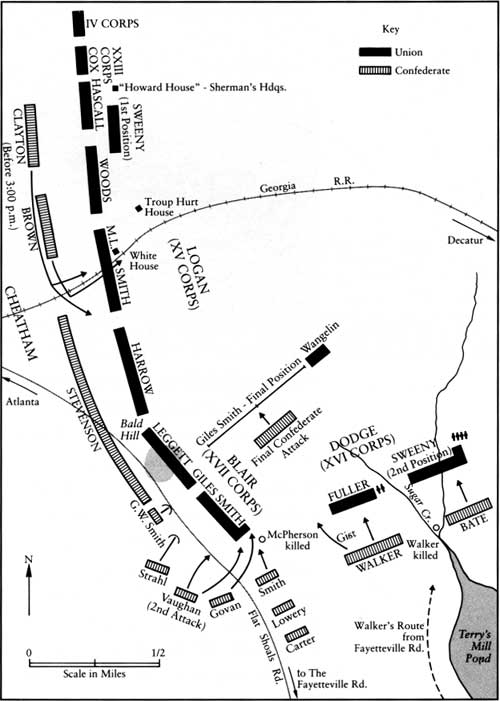
|
BATTLE OF THE BALD HILL, JULY 22
On the evening of July 21 Hardee's Corps, accompanied by Wheeler's
cavalry, began marching southward with the object of swinging around the
Union left flank to Decatur, where it would strike McPherson's forces,
after which it was to join Cheatham's and Stewart's Corps in sweeping
the rest of the Union army toward the Chattahoochee. When it became
evident that Hardee could not reach Decatur by morning, Hood authorized
him to attack on getting into the immediate rear of McPherson. Hardee
could not accomplish this until afternoon on July 22. His two right
divisions, Walker's and Bate's, encountered Dodge's XVI Corps, which
repulsed them. Only Cleburne's and a portion of Maney's division
succeeded in penetrating a gap between the XVI and XVII Corps, in the
process killing McPherson, and then bending back the XVII Corps until it
occupied a line facing southward that was anchored on an elevation
called the Bald Hill. Hood sought to transform this partial victory into
a complete one by having Brown's and Clayton's Divisions attack the XV
Corps. Two of Brown's brigades broke through along the Georgia Railroad.
But a counterattack by the XV Corps drove back Brown's troops and ended
the Confederate threat in this sector. Even though Hardee continued to
assail the Bald Hill until nightfall, he failed to seize it and the
battle ended in another bloody defeat for Hood.
|
Hoping to help Hardee take the hill, Hood ordered Cheatham to attack
the XV Corps, which was astride the Georgia Railroad and to the right of
the XVII Corps. Thanks to an inadequately defended railroad cut, two
brigades from Brigadier General John C. Brown's Division (formerly
Hindman's) penetrated the XV Corps' line and captured a four-gun
battery. Their success, however, was short-lived. A Union counterattack,
personally led by "Black Jack" Logan, who had assumed command of the
Army of the Tennessee on McPherson's death, drove the Confederates back
and restored the XV Corps' front. To the south, Hardee continued to
assault the bald hill with both infantry and artillery until after it
was dark, but to no avail as its defenders held on grimly. (The hill
became known as Leggett's Hill after the commander of the XVII Corps
division that defended it, Brigadier General Mortimer Leggett, who after
the war purchased it.)
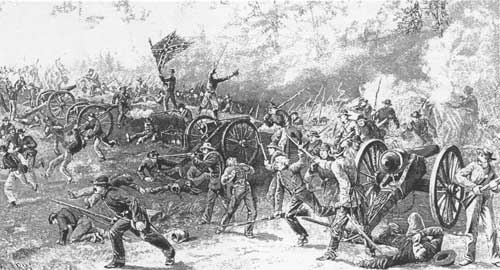
|
CONFEDERATE TROOPS OVERRUN A UNION BATTERY DURING THE BATTLE OF ATLANTA.
(FROM MOUNTAIN CAMPAIGNS IN GEORGIA)
|
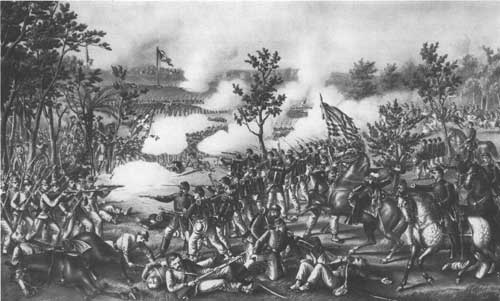
|
THE PERIOD PRINT DEPICTING THE BATTLE OF ATLANTA SHOWS SOMEWHAT
INACCURATELY THE DEATH OF GENERAL JAMES MCPHERSON. (LC)
|
Night ended what would be called the Battle of Atlanta, the largest
engagement of the Atlanta campaign, one that cost the Confederates about
5,500 casualties and the Federals nearly 4,000, a large proportion of
whom were prisoners from the XVII Corps. Again Hood failed in an attempt
to smash a wing of Sherman's army, a failure he attributed to Hardee for
allegedly not carrying out orders to strike the Union rear but which in
truth was caused by the semifortuitous presence of the XVI Corps in
position to protect that rear and the steady fortitude of the soldiers
of the XVII Corps. On the other hand, Sherman deserved little credit for
the Federal victory, a victory which probably would have been a defeat
had not McPherson persuaded Sherman to modify his orders regarding the
XVI Corps. Moreover, during Cheatham's attack on the XV Corps, Sherman
rejected proposals from Schofield and Howard that their corps strike
Cheatham's exposed left flank, a move that almost surely would have led
to the rout of two-thirds of Hood's army.
|
|
